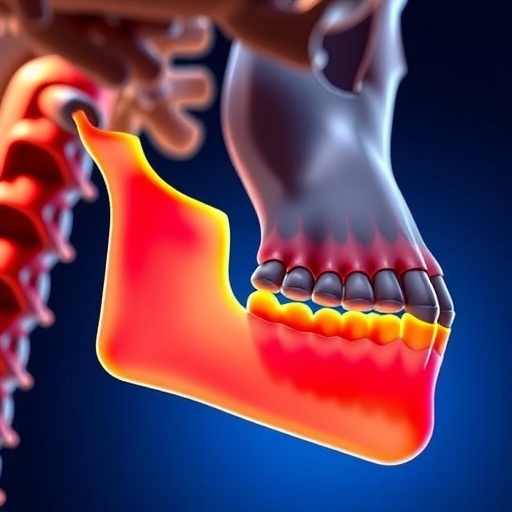
In the evolving landscape of osteoporosis treatment, intravenous bisphosphonates have cemented their role as a cornerstone therapy, providing substantial benefits in reducing fracture risk and improving skeletal health. However, a pressing clinical concern has shadowed the widespread use of these agents: the development of osteonecrosis of the jaw (ONJ). This debilitating condition, characterized by the death of jawbone tissue, impairs patient quality of life and complicates dental care management. The latest study emerging from a collaborative team led by Park, Kong, and Lee, published in Nature Communications, sheds new light on the temporal relationship between the timing of the last intravenous bisphosphonate dose and the risk of developing ONJ in patients with osteoporosis. Their findings hold transformative implications for patient monitoring and treatment scheduling, marking a significant stride toward safer management paradigms in bisphosphonate therapy.
Bisphosphonates function by inhibiting osteoclast-mediated bone resorption, thus stabilizing bone density and decreasing the incidence of fractures among osteoporotic patients. Intravenously administered bisphosphonates, such as zoledronic acid, offer the advantage of higher bioavailability and less frequent dosing schedules compared to oral formulations. Despite these therapeutic gains, their potent suppression of bone turnover has been implicated in rare but severe adverse effects like ONJ, a syndrome whose pathogenesis remains incompletely understood.
This new research rigorously investigates how the elapsed time since administering the last intravenous bisphosphonate dose influences ONJ risk, aiming to define safer treatment intervals. A sophisticated cohort analysis incorporating thousands of osteoporotic patients undergoing intravenous bisphosphonate therapy allowed the investigators to map ONJ incidence against dosing timelines with unprecedented precision. They discovered that the risk of ONJ does not remain constant but diminishes significantly as more time passes after the last bisphosphonate dose, suggesting a reversible component in the drug’s jawbone toxicity profile.
From a mechanistic standpoint, bisphosphonates’ affinity for hydroxyapatite within bone results in prolonged skeletal retention, modulating bone remodeling processes for months or even years beyond administration. The jawbone is particularly vulnerable due to its high remodeling rate and exposure to microtrauma during mastication and dental procedures. The study highlights that with increasing intervals since the last dose, the residual bisphosphonate reservoir in the alveolar bone diminishes, allowing for partial restoration of osteoclastic activity and reparative capacity, thereby lowering ONJ risk.
Furthermore, the research meticulously controls for confounding variables such as age, sex, renal function, concomitant corticosteroid use, and invasive dental procedures, all of which have been implicated as ONJ risk factors. By adjusting for these parameters, the team isolated the temporal effect of bisphosphonate withdrawal to elucidate a clear dose-to-risk gradient. This nuanced approach sets a new standard for epidemiological studies examining adverse drug effects, combining clinical insights with robust biostatistical frameworks.
Clinicians and patients alike stand to benefit from these insights, which could inform personalized treatment plans balancing fracture prevention with minimizing ONJ incidence. One of the critical practical takeaways is the potential merit of instituting “drug holidays” or carefully timed cessations of intravenous bisphosphonate therapy, particularly before dental surgeries or other interventions known to elevate ONJ risk. The data advocates for a minimum drug-free interval, possibly extending beyond current clinical guidelines, tailored to patient-specific risk profiles.
In addition to clarifying temporal risk patterns, the study prompts a revisit of the molecular underpinnings of ONJ. The reversible nature of risk suggests that the bone microenvironment regains its homeostatic remodeling capacity over time once bisphosphonate levels wane sufficiently. This insight fuels ongoing research into targeted therapies that could expedite bone healing or counteract drug-induced remodeling suppression, opening avenues to mitigate ONJ without compromising the anti-fracture benefits of bisphosphonates.
The findings also beckon a broader reevaluation of treatment algorithms for osteoporosis, particularly in populations with high procedural dental needs or comorbidities predisposing to impaired bone healing. Strategically timing bisphosphonate administration to avoid periods of dental intervention may become a standard precaution, reducing morbidity associated with ONJ. Moreover, this temporal risk framework could inform regulatory policies and guidelines issued by osteoporosis and dental health authorities globally.
Methodologically, the strength of this work lies in its integration of real-world clinical data with mechanistic insights derived from bone remodeling theory and pharmacokinetics of bisphosphonates. The longitudinal design, extensive patient follow-up, and rigorous endpoint adjudication add robustness rarely encountered in studies of drug-induced adverse events. Importantly, the new evidence dispels the notion of a static ONJ risk landscape by introducing a dynamic temporal dimension hitherto underappreciated by clinicians.
The implications extend beyond osteoporosis treatment, as bisphosphonates are employed in various oncological settings to manage bone metastases. While dosages and patient populations differ, the principle of time-dependent ONJ risk modulation may inform broader oncologic supportive care strategies. Future research inspired by these findings may assess whether similar risk attenuation occurs in these contexts and how dosing schedules might be optimized accordingly.
Further investigative efforts are warranted to delineate optimal timing thresholds for bisphosphonate cessation, integrating genetic, metabolic, and microbiome factors that may influence individual susceptibility to ONJ. Emerging imaging modalities and biomarkers of bone turnover could refine risk stratification, enabling precision medicine approaches to skeletal health management. The current study lays crucial groundwork upon which such next-generation clinical tools can be developed and validated.
The authors’ multidisciplinary approach, bridging clinical epidemiology, pharmacology, and bone biology, exemplifies the level of collaboration necessary to tackle complex adverse effects rooted in drug-bone interactions. Their findings not only enrich the scientific understanding of bisphosphonate-related ONJ but also spark a wider conversation about balancing therapeutic benefits against rare but impactful complications in chronic disease management.
Ultimately, embracing the nuanced insights from this landmark investigation will empower healthcare professionals to optimize osteoporosis therapies, enhancing patient outcomes while vigilantly minimizing harm. This research marks a pivotal moment in the ongoing quest to refine bone health interventions, underscoring that timing — often overlooked — can be as critical as dose and drug choice in clinical decision-making.
The study by Park, Kong, and Lee heralds a paradigm shift, underscoring that judicious management of bisphosphonate dosing intervals can mitigate jawbone necrosis risks without forsaking fracture prevention. As the osteoporosis epidemic continues to grow globally with aging populations, such evidence-based refinements to treatment protocols will be instrumental in safeguarding the skeletal integrity and quality of life for millions.
In conclusion, this seminal work redefines the temporal dynamics of bisphosphonate-associated osteonecrosis risk, transforming clinical practices and inspiring a new generation of research aimed at unraveling and overcoming drug-induced skeletal complications. It is a clarion call for heightened awareness regarding the timing of intravenous bisphosphonate administration, heralding safer therapeutic horizons in osteoporosis care.
Subject of Research: Time-dependent risk of osteonecrosis of the jaw following last intravenous bisphosphonate administration in osteoporotic patients.
Article Title: Time since last intravenous bisphosphonate and risk of osteonecrosis of the jaw in osteoporotic patients.
Article References:
Park, JH., Kong, S.H., Lee, J. et al. Time since last intravenous bisphosphonate and risk of osteonecrosis of the jaw in osteoporotic patients.
Nat Commun 16, 4367 (2025). https://doi.org/10.1038/s41467-025-59718-x
Image Credits: AI Generated
Tags: bisphosphonate therapy and jaw osteonecrosisimplications of bisphosphonates in dental careimproving safety in osteoporosis treatmentsintravenous bisphosphonates and osteonecrosisjawbone tissue necrosis in osteoporosismonitoring bisphosphonate side effectsosteoclast inhibition and bone healthosteoporosis treatment strategiespatient management in bisphosphonate therapyrisk factors for jaw osteonecrosistiming of bisphosphonate administrationzoledronic acid and fracture risk





